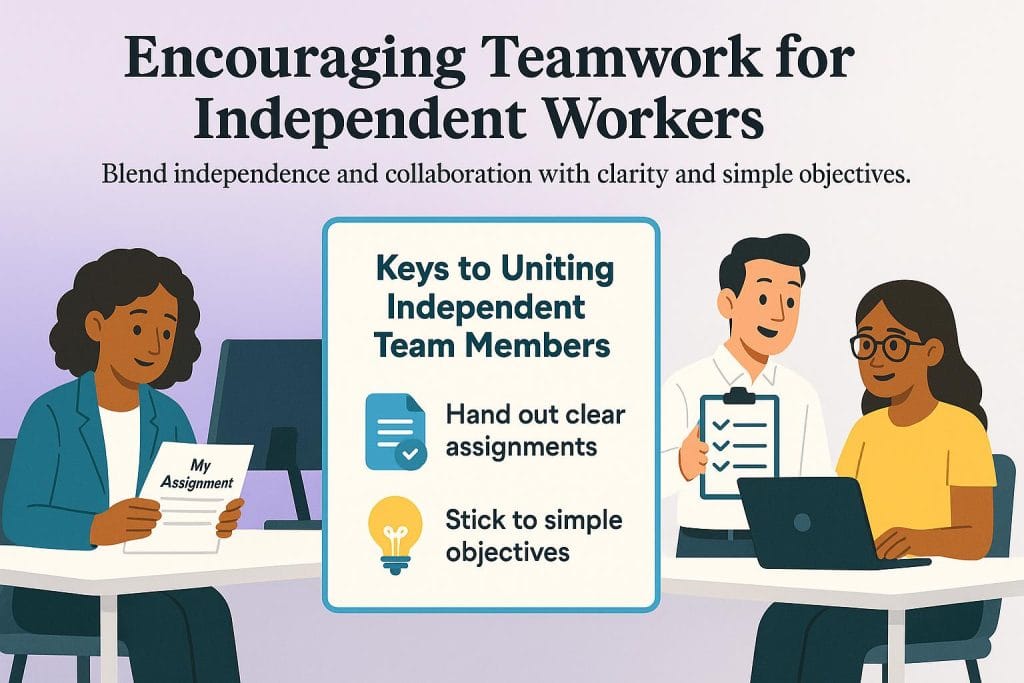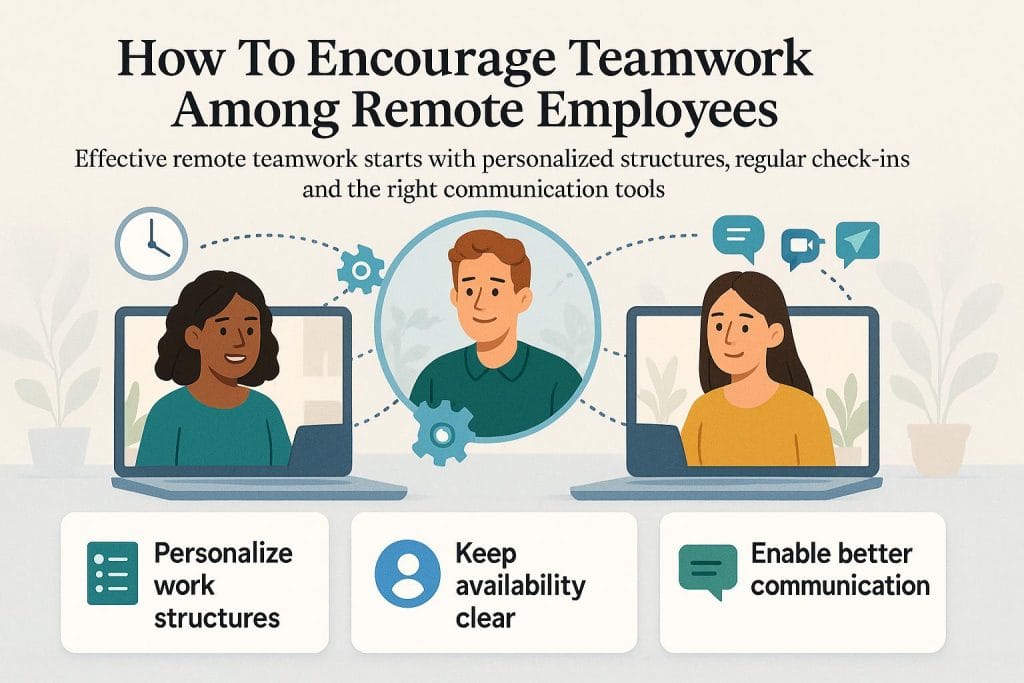Business.com aims to help business owners make informed decisions to support and grow their companies. We research and recommend products and services suitable for various business types, investing thousands of hours each year in this process.
As a business, we need to generate revenue to sustain our content. We have financial relationships with some companies we cover, earning commissions when readers purchase from our partners or share information about their needs. These relationships do not dictate our advice and recommendations. Our editorial team independently evaluates and recommends products and services based on their research and expertise. Learn more about our process and partners here.
Working as a Team: The Importance of Teamwork in the Workplace
Learn the benefits of teamwork and some tips to boost your team's productivity and overall communication.

Table of Contents
Without good old-fashioned teamwork, most of today’s top-selling businesses wouldn’t be here to ride the waves of success. Many studies show the power of collaboration and how it can produce a healthy work environment, happy workers and positive results for businesses. And while the fundamentals of teamwork are universal, what it takes to foster effective teamwork may look slightly different for each person and company. Learn why teamwork is important and how you can encourage working as a team within your organization.
>> Read Next: Collaboration Improves Workplace Performance. Here’s How to Encourage It
Importance of teamwork in the workplace
Teamwork in the workplace improves communication, efficiency and synergy. It also fosters emotional support and creates healthy competition.
1. Teamwork improves communication.
Teamwork involves the active sharing and discussion of information and ideas and includes many points of view. Team members all learn from each other and discover new ways of thinking through projects. An environment with clear and open communication can quickly lead to successful results, no matter the industry.
However, despite the importance of open communication, Project.co’s 2024 communication research found that 30 percent of people feel that communicating with clients and co-workers has become more difficult. This highlights the growing need for organizations to strengthen their collaboration strategies and foster more effective team interactions.
Here are some tips for achieving better group communication.
- Listen first. Your fellow team members may have ideas and opinions that will boost creativity and efficiency. Make sure you give them the floor to share their thoughts and opinions.
- Make sure what you say and what you do have the same message. In other words, keep your verbal and nonverbal language on the same page. This limits confusion.
- Validate others’ contributions. Compliment team members on good ideas and suggestions. This makes them feel a part of the team and encourages future participation.
- Learn the communication preferences of your teammates. Get to know how your fellow team members want to receive information. Perhaps some prefer detailed outlines and reports, while others thrive on conversational exchanges.
2. Teamwork supports a leaner, more efficient organization.
A natural organizational benefit of teamwork is the lean structure it produces, cutting down on middle management and leading to greater freedom, innovation and progress. This is not to say middle managers are useless, but flat organizations have their advantages. A team that is given the freedom to create and operate is likely to succeed, and a team with relatively equal voices is a crucial element of successful business practices.
Here are some benefits your team can reap from lean methods.
- More efficiency: The lean mindset aims to eliminate wasteful procedures, allowing workers to boost productivity and increase customer satisfaction. Value-stream mapping is a technique many teams use to track every step of the product development process, from starting point to delivery. This helps them visualize what may or may not provide value.
- Fewer bottlenecks: Bottlenecks are hindrances to any organization’s overall workflow, preventing the achievement of deadlines and any sense of productivity. Lean methods, however, mean teams share their work equally, ensuring tasks are completed in a timely manner. Brainstorming and problem-solving can prepare for or prevent any business disruptions.
- Lower costs: With lean practices, a company can save money and add value by eliminating waste caused by overproduction, overhiring or the accumulation of bottlenecks in the production process.
- Continuous improvement mindset: Lean methodology promotes the constant improvement of teamwork and business practices within large or small organizations. Workers should offer and receive feedback from top to bottom so they can improve products and accelerate innovation.
3. Teamwork fosters emotional and psychological support.
A workplace centered around teamwork is ripe to provide emotional support, as the dynamic involves many colleagues working together. This could be physically alongside one another or online, with constant communication. Providing emotional support can mean avoiding overly harsh critiques when discussing one’s work or checking in to see how a fellow team member is coping.
Emotional and psychological support can even go beyond the workplace, which may have a reciprocal effect. For example, sending a card is a simple and office-appropriate way to provide quick support to a fellow employee. Team-related emotional support leads to much deeper workplace happiness and success.
4. Teamwork creates healthy competition.
Though you might assume employee competition leads to infighting, credit-hogging and blaming, the opposite is true when a workplace encourages healthy competition. Teamwork can rapidly increase positive competitiveness, with collaborative teams often experiencing increased motivation and productivity, better sales results, and improved customer engagement.
Here are some tips for setting up friendly workplace competitions.
- Make it team-based, not individual-based. When you set up group challenges instead of individual ones, you’ll ensure team members collaborate and rely on each other.
- Provide equal opportunities for all competitors. Set up a structure that doesn’t favor certain employees. Create challenges that utilize everyone’s various skill sets and don’t privilege any specific background.
- Set reasonable deadlines. Don’t make your staff work overtime to keep up with an unrealistic deadline. Your challenges should be attainable and fun.
5. Team synergy drives stronger outcomes.
Synergy is the interaction or cooperation of two or more organizations, substances or other agents to produce a combined effect greater than the sum of their parts. Synergy can look like many things in the workplace, but it typically involves the benefits of teams sharing their competencies and capacities.
When colleagues don’t work together, it’s easy to see the devastating effect a lack of synergy can have on an organization. But when synergy is present, productivity will be high. Responses from workers are more clear-cut, business goals are better understood, collaboration increases and problems are solved because everyone feels motivated as they put their heads together to tackle shared objectives and challenges.
Your business can benefit from synergy when your team members have diverse skills and backgrounds as well. When developing a product, you don’t just need marketers — you need additional professionals like copywriters, analysts, and specialty research and development workers. When everyone brings their own special skills and perspectives to the table, the result is improved workflow, an increase of transformative ideas and a more refined product thanks to the minds and hands of numerous critical thinkers.
How to encourage teamwork in the workplace for in-office employees

Creating an effective collaborative environment for in-office teams requires intentional strategies that foster communication, trust and shared purpose. According to Gallup’s employee experience research, the quality of management explains 70 percent of the variance in team engagement, underscoring managers’ crucial role in building collaborative teams. Here’s how to encourage teamwork among your in-office employees.
Create collaborative physical spaces.
The foundation of workplace collaboration begins with designing your office layout to facilitate both planned and spontaneous collaboration. This includes creating open collaboration zones with comfortable seating, whiteboards, and easy access to technology, while also providing quiet spaces for focused work that don’t isolate team members completely. Meeting rooms of various sizes should accommodate different group dynamics, and breakout areas should allow informal conversations to happen naturally.
Gensler’s Global Workplace Survey Comparison found that office workers spend most of their time (42 percent on average) collaborating with others, which makes the physical environment crucial for team success.
Implement regular team-building activities.
According to Gallup’s employee engagement research, only 31 percent of U.S. employees were engaged at work in 2024, down from 33 percent in 2023, highlighting the critical need for structured team-building initiatives that strengthen team connections and employee engagement. Cross-departmental projects that require different skill sets and perspectives help break down silos, while regular team lunches or coffee breaks foster informal connections that strengthen working relationships. Problem-solving workshops where teams tackle real business challenges together create shared experiences and mutual respect, and skills-sharing sessions where team members teach each other their expertise build both competence and camaraderie.
Establish clear communication protocols.
Establishing clear communication protocols ensures that information flows effectively across the team. Daily stand-up meetings help align everyone on priorities and identify potential roadblocks before they become major issues. Shared digital workspaces where team members can access project information and updates keep everyone informed and accountable. Regular feedback loops ensure everyone’s voice is heard and valued, while clear role definitions help team members understand their responsibilities and how they contribute to team goals.
Recognize and reward collaborative behaviors.
Finally, making collaboration a valued behavior through recognition and incentive systems reinforces the importance of teamwork. Team achievement celebrations that acknowledge collective success rather than individual accomplishments send a clear message about organizational values. Peer nomination programs where team members can recognize each other’s collaborative efforts build positive reinforcement loops, while incorporating collaborative performance metrics into individual performance reviews ensures accountability. Public recognition of teams that demonstrate exceptional collaboration and results motivates others to follow suit.
How to encourage remote employees to work as a team

It’s fair to say enthusiasm for working from home has probably never been higher. Not only is the flexibility of remote work a plus, but home workers are also seeing they’re able to get more work done than they previously thought possible. In fact, Airtasker found that remote workers only lose 27 minutes of work each day due to distractions, compared to office workers’ 37 minutes lost.
A remote company may not lend itself to teamwork at first glance, but there are plenty of ways to still reap the benefits of collaboration if you have a distributed workforce. Here’s how to encourage teamwork among your remote employees.
Personalize work structures for remote employees.
Some workers strictly adhere to a routine, while others are more laid back. Instead of treating all your remote employees the same way as your in-office workers, personalize work structures, objectives and outcomes to fit each person. Then, encourage colleagues to find commonalities and ways they can work together instead of in silos.
Set clear collaboration boundaries and expectations.
Set windows for meetings and general hours to talk, email and submit work for deadlines. Be careful not to blur the lines between productively working at home and overworking past a normal workday schedule. Be just as fair to remote workers as you are to in-office workers. [Read more about flextime and flexible work schedules.]
Leverage advanced collaboration technologies.
According to Project.co, 75 percent of businesses implemented new communications tools in 2024. If you want your remote team to stay productive and connected, make sure they have access to the right software. Some of the most effective collaboration platforms include:
- Integrated messaging systems like Slack or Microsoft Teams for real-time communication
- Video conferencing platforms like Zoom or Google Meet with screen sharing and breakout rooms
- Project management tools such as Asana, Trello or monday.com for task coordination
- Cloud-based document sharing through Google Workspace or Microsoft 365 for seamless file collaboration
- Virtual whiteboard tools like Miro or Mural for brainstorming and visual collaboration
Technology can drive progress by connecting employees with customers, coworkers and partners despite their remote location. Encourage your team to learn basic video conferencing etiquette, and offer chat-based tools for those who prefer a more relaxed way to communicate.
Maintain regular virtual team connections.
By checking in every day with your remote team through video calls and meetings, you’ll maintain a virtual environment built on collaboration and support. This time can forge a sense of togetherness and enhance team camaraderie, especially if you allow time for people to catch up with one another personally. As team members continually get to know one another better, they’ll be more apt to work together despite a physical divide.
How to encourage working as a team for those who prefer independent work
Some workers prefer independent work, and that’s OK. There are strategies you can use to encourage teamwork while still respecting employee preferences.
Clearly define roles and responsibilities.
When you clearly designate roles and responsibilities to each of your team members, you can avoid confusion and the risk of one person trying to take full control. When dealing with new projects, give both seasoned and new professionals a chance to work on something fresh and demonstrate their strengths.
Set clear goals.
When assigning special projects or work to be completed, make sure the goals of these assignments aren’t ambiguous. Ambiguity can cause some team members to doubt themselves and question their work. Instead, set short- and long-term goals to motivate the whole team to work together toward a shared victory.
Let everyone contribute.
Give everyone on the team a chance to involve themselves in projects that demand collaboration and thinking outside the box. Let everyone pitch their ideas, let them know you’re taking them into consideration and integrate the concepts into your final plans. This will lead team members to feel more invested and motivated as they come together to create solutions.
Reward teamwork.
Never hesitate to reward your employees for a job well done. When workers complete a project to high standards or go above and beyond expectations, bring that to the attention of the company as a whole. Congratulate your team members formally by letting everyone in the office know the results their exceptional teamwork produced.
You should also cheer your team on informally through messaging channels where you can use emojis in your tribute, especially if you’re recognizing remote workers who can’t be celebrated in person. This will encourage and reinforce the importance of teamwork in the workplace. It may even convince independent workers to switch their approach to work more closely with others to achieve better results.
Skye Schooley and Shlomo Wiesen contributed to this article.










